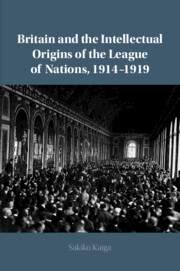Book contents
- Britain and the Intellectual Origins of the League of Nations, 1914–1919
- Britain and the Intellectual Origins of the League of Nations, 1914–1919
- Copyright page
- Contents
- Acknowledgements
- Abbreviations
- Introduction
- 1 Precursors
- 2 The Use of Force to Prevent War?
- 3 Strategies for Winning Public Opinion
- 4 A Transnational Movement?
- 5 No Peace without Victory
- Conclusion
- Appendix
- Bibliography
- Index
4 - A Transnational Movement?
The British and American Pro–League of Nations Groups, 1914–1918
Published online by Cambridge University Press: 27 April 2021
- Britain and the Intellectual Origins of the League of Nations, 1914–1919
- Britain and the Intellectual Origins of the League of Nations, 1914–1919
- Copyright page
- Contents
- Acknowledgements
- Abbreviations
- Introduction
- 1 Precursors
- 2 The Use of Force to Prevent War?
- 3 Strategies for Winning Public Opinion
- 4 A Transnational Movement?
- 5 No Peace without Victory
- Conclusion
- Appendix
- Bibliography
- Index
Summary
Chapter 4 examines the influence of the Bryce Group’s war prevention plan more broadly, scrutinising the relationship between the League of Nations Society and its counterpart in the United States, the League to Enforce Peace. While scholars have hardly analysed the two groups’ interactions, both groups sprang from the liberal internationalist tradition, had a lot in common in terms of social background and worked for the same aim of reforming the global order. Such similarities, however, did not enable them to establish a constructive collaboration, let alone a transnational movement. In reality, both groups sought political support for their own post-war schemes and regarded their counterpart merely as a medium for approaching statesmen on the other side of the Atlantic. Moreover, the differences in their domestic contexts and in the British and American liberal internationalist traditions hindered the two groups from building mutual trust and a joint lobbying strategy.
Keywords
- Type
- Chapter
- Information
- Publisher: Cambridge University PressPrint publication year: 2021

